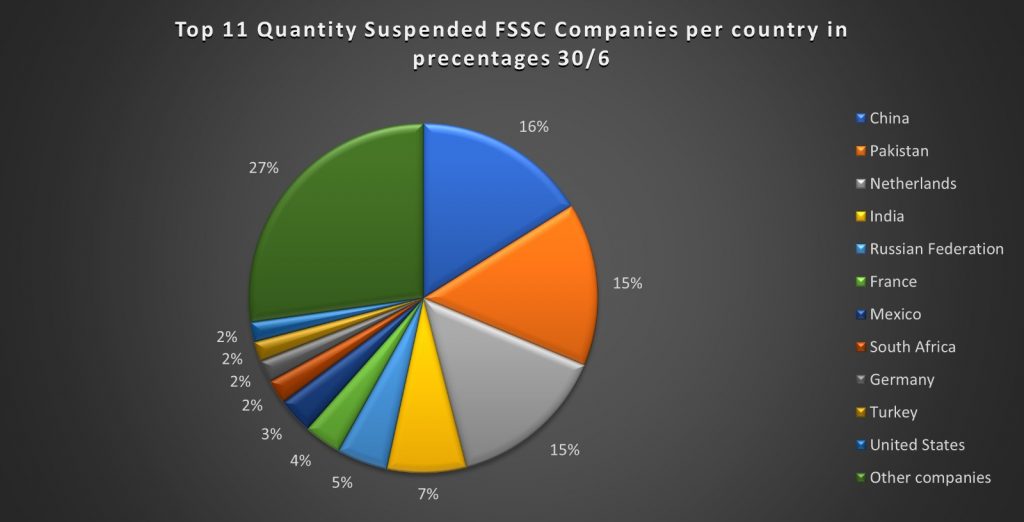Explanation 32 folder methodology
The following table will go through and explain the 32 folder structure.
| Folder | Description |
|---|---|
| 01-A-System | System folder: The company has a systematic approach to business planning, external visits, and requesting analysis certificates. |
| 01-B-Quality-handbook | Quality handbook: HACCP and quality assurance standard related to procedures, instructions, and registration forms are up-to-date. |
| 01-C-HACCP-study | HACCP study: The HACCP study method and result have been recorded (with version number). The HACCP team is described with members and HACCP-related competences. The study is based on the product specifications, in accordance with which the company wishes to deliver. The risks of third parties (both raw material and outsourced production) are also included in the scope of the study. |
| 02-Customers | Customer demands: The company has recorded the most recent customer demands. This concerns terms of delivery, customer audits, customer questionnaires, and product specification format. QA relevant information is often also recorded in contracts. Also organize the QA relevant matters with customer requirements and make them available to the organization. Customer satisfaction survey results also belong in this folder. |
| 03-Suppliers | Suppliers: The company has recorded the most recent purchasing demands. This concerns general terms of delivery, specific terms of delivery, supplier audits, supplier questionnaires, and product specification format. The newest certifications are known to suppliers. QA relevant information is often also recorded in contracts. |
| 04-Raw-materials | Raw materials: Recent product specifications are available for all raw materials. These are also recorded in iMIS Food. |
| 05-Commodities | Commodities: Recent product specifications are available for all commodities. These are also recorded in iMIS Food. The information required in folder 3 (suppliers) is also required from suppliers of commodities. |
| 06-Packaging | Packaging: Recent product specifications are available for all packaging. These are also recorded in iMIS Food. The information required in folder 3 (suppliers) is also required from suppliers of packaging. |
| 07-Industrial-resources | Industrial resources: Recent product specifications are available for all industrial resources. These are also recorded in iMIS Food. The information required in folder 3 (suppliers) is also required from suppliers of industrial resources. |
| 08-End-products | End products: End product specifications. This folder has been released for communication to third parties. |
| 09-Recipes | Recipes: Composition of the ingredients related to food safety or maximum legal standards. Information in / out of iMIS Food. Pay attention to recipe monitoring. |
| 10-Complaints | Complaints: Purchasing and sales complaints. This folder is aimed at handling food safety related complaints. Shortages and etc. can be found directly in customer communication and the tracking system. |
| 11-Storage | Storage: The complete cooling system. Assurance of temperatures, calibrations, maintenance contracts, and compliance. |
| 12-Inspections | Inspections: Overview of inspections and reports. Several inspection rounds also have an incident report function! Corrective measures must be noted in the event of abnormalities. |
| 13-Corrective-measures | Corrective measures: Overview of corrective measures. These arise from the inspection rounds and reports, complaints, HACCP team consultation, and (external) audits. |
| 14-Maintenance | Maintenance: Maintenance contracts and planning. Machine cards indicate the status of the machines. Maintenance schedule is monitored. Contracts indicate who is responsible for what. |
| 15-Hygiene-management | Hygiene management: Cleaning and disinfection plan, description of cleaning performed, pest plan, description of layout with all bait boxes. Also, the cleaning of the vehicles. |
| 16-Production | Production: Production planning and registrations |
| 17-Packing | Packing: Packing planning and registrations |
| 18-Transport | Transport: Transport planning and registration |
| 19-Labratory | Laboratory: Microbiological planning and execution. The EU 2073 is only the minimum research prescribed by the Dutch Food Safety Authority. Furthermore, through the EU 854, the HACCP study ensures that product specifications must be met. This usually includes around 10 parameters which can be tested. QA standards require shelf life testing against the most extreme customer conditions. |
| 20-Development | Development: New product / process combinations are recorded here. Please note: the tracing of used raw materials for testing must also be arranged! HACCP study updates also belong in this folder. |
| 21-Process-controls | Process controls: Process controls are / are not CCP related. With CCP related inspections, a company must respond “on time” in case of abnormalities! Make sure that the checks are done with the correct measuring instruments. |
| 22-Year-planner | Year planner: Verification report, validation report, internal audits, management review, tracking test (both ways), and recall test. |
| 23-Improvement-projects | Improvement projects: iMIS Food presentation is often 100% of the improvement program. Any major architectural adjustments. |
| 24-Training | Training: Overview of all relevant and provided training in the company. |
| 25-Waste | Waste: Overview of all waste flows in the company. And registration of what is collected when by whom. |
| 26-Calibration | Calibration: Overview diagram of all measuring instruments to be calibrated, such as pH meter, scales (CCP related or end product), temperature meters, sensors for cooling systems and cooking cabinets, gas meter, and etc. |
| 27-Legislation | Legislation: Legislation overview. System audits and UBA. And communication with government authorities. |
| 28-Certification | Certification: Overview of QA standards and certification body communication. |
| 29-Personnel | Personnel: Personnel files regarding the quality system, HACCP, and training. Training and training overview. With annual assessment of QA performance. iMIS Food also contains inspection rounds that can be linked to the file. |
| 30-Product-tracking | Tracing: Raw materials, sub-products, end products, clients, external storage, and packaging material trays. |
| 31-Hygiene-photobook | Hygiene photobook: Photos |
| 32-Publication-board-and-Visitors | Publication board and visitors: Publication board: What has been communicated in the past year? Visitors list: Who came in when with who and why? |
Monitoring
| Folder | Check questions |
|---|---|
| 01-A-System | Is there a total overview of the company and what is the status? |
| 01-B-Quality-handbook | Is the QA handbook up to date? Are the newest changes in it? |
| 01-C-HACCP-study | Are the outsourced activities part of the study? Is it well recorded in contracts with third parties (including co-packers) who owns the processing? And what if metal is found? |
| 02-Customers | Has it been formally established who can sign all these forms? Legally, product specifications are contracts. From a legal point of view, contracts can only be signed by authorized signatories known to the Chamber of Commerce. Customer satisfaction can also be measured with complaints and turnover performance. BRC demands indicators for this satisfaction. Was an customer satisfaction survey prescribed by the company carried out and included in the management review? |
| 03-Suppliers | Has it been formally established who can sign all these forms? Legally, product specifications are contracts. From a legal point of view, contracts can only be signed by authorized signatories known to the Chamber of Commerce. Customer satisfaction can also be measured. |
| 04-Raw-materials | Are specifications up to date? In any case, it is good to request this information again every year. Be especially alert to mutations in the allergen composition of a product. This must be directly translated to the end label and any impact on the production sequence. |
| 05-Commodities | Are the specifications up to date? In any case, it is good to request this information again every year. Be especially alert to mutations in the allergen composition of a product. This must be directly translated to the end label and any impact on the production sequence. |
| 06-Packaging | Is there information available regarding migration tests? |
| 07-Industrial-resources | Are the Safety Data Sheets and Product Sheets available for all cleaning products? And also with the storage of these resources? Are the product and safety date sheets available for all pest control agents used? |
| 08-End-products | Who is responsible for the recipes? Who checks whether the items are correctly entered in iMIS Food? |
| 09-Recipes | Who communicates specifications to third parties? Note: This concerns legal liability. A recall can be caused by forgetting an allergen or a supplier who changed the raw material without knowledge. |
| 10-Complaints | When registering complaints, it is important to formally close complaints processes as well. Also, look at how long the complaints process takes towards both the supplier and the customer. Complaints are an important indicator of QA system performance. |
| 11-Storage | Are the contracts and compliance comprehensive? What about external storage? Has external storage been included in the supplier assessment and HACCP study? |
| 12-Inspections | Are the rounds up to date? When a new machine comes into use, are the lists updated? For example, demonstrate this with a new machine that was recently purchased. |
| 13-Corrective-measures | Have the corrective measures been resolved within a reasonable time? Even in the case of deviating microbiological values, it must be established from 2073 what the cause analysis or correction is. |
| 14-Maintenance | Please note, the company itself is responsible for compliance with contracts. For a new machine, the release must be recorded and the maintenance plan must be adjusted. |
| 15-Hygiene-management | Check whether all machines are in the plans and new areas, are the agents used and dosage correct? What is the content of the cleaning contract? Is it in detail who is responsible for what? What if a recall occurs due to disinfection or improper cleaning? |
| 16-Production | Are these registrations properly measured and completed? Does the person registering know what is being registered and why? |
| 17-Packing | Are these registrations properly measured and completed? Does the person registering know wat is being registered and why? Is it known exactly how, for example, the correct gas mixture is added or vacuumed? Are the labels and product codes correct? |
| 18-Transport | What if a batch is not longer good? Is delivery temperature on the receipt? |
| 19-Labratory | Agar control is to test the cleaning effectiveness. In the event of abnormalities, correction should be made to the process and not only the sampled product. |
| 20-Development | Are there any development forms that record the most recent new products? A small adjustment or product variant does not require an extensive form. |
| 21-Process-controls | Who is responsible for which check? Is this also arranged in case of absence? Check the people whether they are also trained in the controls. Is the value recorded at the time of measurement? |
| 22-Year-planner | Have all the mandatory components been completed? Has the recall procedure been adjusted for food authority changes or recall learning moments? |
| 23-Improvement-projects | |
| 24-Training | Is everyone who is specifically responsible for a HACCP section trained, and has this been documented? Also record internal training! |
| 25-Waste | Are the contracts still up to date? |
| 26-Calibration | Up to date, numbered, and calibrated? Are instructions for use available for all meters? People trained in this? |
| 27-Legislation | What are the latest comments from the food authorities? Or not: Let QAssurance assess the relevance. |
| 28-Certification | Is there a BRC company cross-table? The old report can be used for follow-up audits. |
| 29-Personnel | Up to date? |
| 30-Product-tracking | |
| 31-Hygiene-photobook | |
| 32-Publication-board-and-Visitors | Also health statements from all visitors and external technicians! |
Related articles to 32 Folder methodology: How does it work in practice?
Many customers and visitors to this page '32 Folder methodology: How does it work in practice?' also viewed the articles and manuals listed below:



